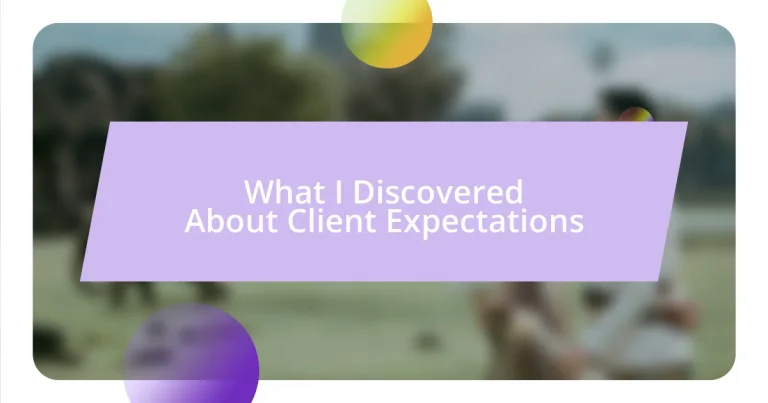Key takeaways:
- Active listening and empathy are essential for understanding and managing client expectations, leading to stronger relationships.
- Establishing clear communication guidelines and regularly checking in can enhance transparency and reassurance, reinforcing client trust.
- Continuous evaluation of client feedback and adapting strategies ensures alignment with evolving goals, ultimately exceeding client expectations.

Understanding Client Expectations
Understanding client expectations can often feel like navigating a maze. I remember a project where we launched a new service, and my team was confident about the value it brought. Yet, it quickly became apparent that clients anticipated a level of personal interaction that we hadn’t prioritized. Their need for communication wasn’t just a preference; it was a crucial part of their experience. Have you ever been in a situation where what you thought was enough turned out to be a mere fraction of what was required?
When I reflect on those moments, I realize that active listening is fundamental to uncovering what clients truly desire. It’s about tuning in to not just their words, but the emotions behind them. One day, a client expressed frustration during a call, and instead of detailing our next steps, I took a moment to empathize and acknowledge their feelings. It transformed our rapport and turned a potential conflict into an opportunity for deeper collaboration.
I’ve learned that setting clear expectations from the outset can significantly impact the client relationship. Often, I find myself asking clients how they define success for our project. This simple question opens up a dialogue that reveals their goals and fears. By aligning our objectives, we create a partnership based on mutual understanding, which ultimately leads to a more satisfying experience for everyone involved. How do you approach discussions on expectations with your clients?

Identifying Common Client Needs
Identifying common client needs often involves looking beyond the obvious. In my experience, many clients crave reassurance that their expectations are being met. I once had a client who, despite a strong project outline, was restless. It turned out they were anxious about timelines, even though we had discussed them in detail. A simple check-in call alleviated their worries, reinforcing the idea that clarity and reassurance can drastically enhance a working relationship.
Another prevalent need is customization. Clients frequently desire solutions tailored specifically to their unique challenges. I recall collaborating with a client whose business model was quite niche. By taking the time to understand their distinct situation and suggesting custom strategies, I not only delivered a successful outcome but also built a trust that has lasted for years. Recognizing these nuanced requirements can set the stage for stronger partnerships.
Lastly, the need for transparency often emerges during projects. Clients appreciate knowing where things stand. I remember a time when a project hit a snag, and rather than waiting for the issue to resolve itself, I decided to keep the client fully informed. Sharing the challenges not only kept them in the loop but also fostered a collaborative spirit. It’s moments like these that remind me of the importance of keeping lines of communication open and honest.
| Client Need | Importance |
|---|---|
| Reassurance | Helps alleviate client anxiety, leading to stronger trust |
| Customization | Ensures solutions fit unique challenges, enhancing satisfaction |
| Transparency | Builds a collaborative environment, fostering trust |

Setting Clear Communication Guidelines
Setting clear communication guidelines can dramatically enhance the client experience. I remember a project where we initially operated on a loose structure for communication, and it caused confusion and frustration. Once we established specific times for updates and preferred methods of communication – like weekly check-ins via video call and quick status emails – the atmosphere transformed. Clients felt more secure knowing exactly when to expect updates, and it allowed our team to focus on delivering value without distractions.
To make sure everyone is on the same page, consider these essential guidelines:
- Preferred Channels: Identify whether clients prefer emails, calls, or messaging apps for communication.
- Response Time Expectations: Set clear timeframes for when clients can expect a reply to their inquiries.
- Regular Check-Ins: Schedule recurring meetings to discuss progress, address concerns, and adjust strategies as needed.
- Meeting Agendas: Send out agendas ahead of meetings to ensure all parties come prepared.
- Feedback Loops: Encourage and incorporate client feedback consistently to refine communications and project goals.
Establishing these guidelines fosters an open, trusting relationship and ensures that everyone feels heard and valued. When clients know what to expect, they often respond with increased engagement and satisfaction.

Aligning Services with Client Goals
When aligning services with client goals, I find that asking the right questions can open up a treasure trove of insights. Once, I worked with a client who seemed satisfied on the surface but had another agenda lurking beneath. During a casual conversation, they mentioned a long-term vision for their company that hadn’t surfaced in our meetings. That moment taught me the value of digging deeper—it’s essential to uncover not just what clients want today, but where they envision their future. How often do we assume we fully understand our clients without encouraging them to share their broader aspirations?
Seeing the connection between client goals and the services we provide can feel like piecing together a jigsaw puzzle. I once guided a start-up aiming to disrupt an industry but needed help defining their unique value. By facilitating a creative workshop, we could flesh out their vision, aligning our services with their mission. The joy of watching that alignment blossom into a successful campaign was fulfilling. It underscored that our role isn’t just endpoint deliverers but partners in their journey toward success.
Ultimately, I believe that alignment requires consistent effort and dialogue. After all, clients change—market conditions shift, and new challenges arise. One time, a longtime client pivoted to a new target audience and initially hesitated to share the news. By fostering an open culture where such shifts could be discussed freely, we adapted our services remarkably to support their new direction. It’s these moments of genuine partnership that build lasting relationships, making it crucial to keep conversations alive and check in about evolving goals regularly.

Managing Expectations Throughout Projects
Managing expectations throughout projects is often the linchpin of successful client relationships. I remember a project where we faced a significant delay due to unforeseen circumstances. Instead of letting the silence create unrest, I proactively reached out to explain the situation in detail. By acknowledging the setback and discussing the impact on timelines, I found that clients appreciated the transparency and felt more in control, transforming potential frustration into understanding.
I can’t stress enough how vital it is to check in with clients regularly, not only to update them on progress but also to recalibrate expectations if needed. Reflecting on another experience, I initiated mid-project reviews and honestly found they were a game changer. Clients were surprised at how engaging these discussions felt; we weren’t just ticking boxes—we were navigating the journey together. It made me think: Do we often underestimate how much clients crave that connection during project milestones?
Moreover, I’ve learned that sharing the project timeline is essential, but what’s even more critical is making the effort to explain the reasons behind each phase. I once had a client who struggled to grasp why an early stage took longer than anticipated. Instead of glossing over it, I took the time to break down the process and its importance, and I could see the relief wash over their face. It reinforced the idea that informed clients tend to be more patient and supportive, as they understand not just the ‘what’ but the ‘why’ behind each step of the project.

Evaluating Client Feedback and Adaptation
Evaluating client feedback is like tuning an instrument; it requires sensitivity and attention to detail. A few years ago, after completing a project, I asked for feedback through a straightforward survey. To my surprise, one client expressed dissatisfaction with an aspect I assumed was fine. Instead of dismissing this feedback, I decided to meet them over coffee to dive deeper into their concerns. What I discovered was enlightening: they valued a different aspect of our service that I hadn’t prioritized. This experience reinforced my belief that taking the time to evaluate every piece of feedback is crucial; it allows us to truly understand our clients and adapt our approach accordingly.
In my journey, I’ve come to realize that adaptation is not a one-time act but an ongoing process. Once, during a campaign, I noticed engagement dropping off after launch. Rather than ignore the data, I reached out to clients for their thoughts. One influential stakeholder shared insights about shifting market dynamics, which prompted us to pivot our strategy. The result? A reinvigorated campaign that not only met but exceeded expectations. Reflecting back, I can’t help but wonder: How often do we miss opportunities for growth simply because we don’t listen closely enough?
I’ve found that the emotional connection I build with clients can greatly influence how they respond to feedback requests. There was a time when I reached out post-project to solicit input, and just by sharing my genuine curiosity about their thoughts, the client opened up about not only the project’s outcomes but also their broader business fears. Listening to their concerns, I recognized the need for psychological safety in our discussions. It’s a strong reminder that when clients believe they can speak freely, the insights they share can lead to transformative changes in my service approach. This two-way communication is essential—after all, isn’t it fascinating to think that the feedback we receive could be the key to unlocking new pathways for success?

Strategies for Exceeding Client Expectations
Delivering exceptional value often hinges on the anticipation of client needs. I fondly recall a project where I initiated a discovery session before the work began. By actively listening to the client’s desires, concerns, and even unspoken wishes, I was able to tailor my approach around their expectations. It was a delightful surprise for them to see their ideas reflected in the project’s trajectory, making it clear that I was not just a vendor, but a partner invested in their success.
Another strategy that has proven transformative is setting benchmarks throughout the project timeline. One time, I established a series of goals with a client at the outset. As we checked off each milestone, I noticed their excitement grow; they felt a true sense of progress and accomplishment. It’s funny how small wins can create a ripple effect, don’t you think? Each achievement was an opportunity to celebrate and affirm our collaborative spirit, making them feel like an integral part of the journey.
Finally, I’ve learned the power of follow-up after a project’s completion. I remember reaching out to a client months later just to see how they were faring post-launch. They were surprised at my thoughtfulness and ended up sharing how the project had positively impacted their business. This moment reminded me that exceeding expectations often comes down to genuine care and a willingness to stay engaged, even after the initial work is done. Isn’t it remarkable how a simple check-in can deepen trust and create lasting relationships?














